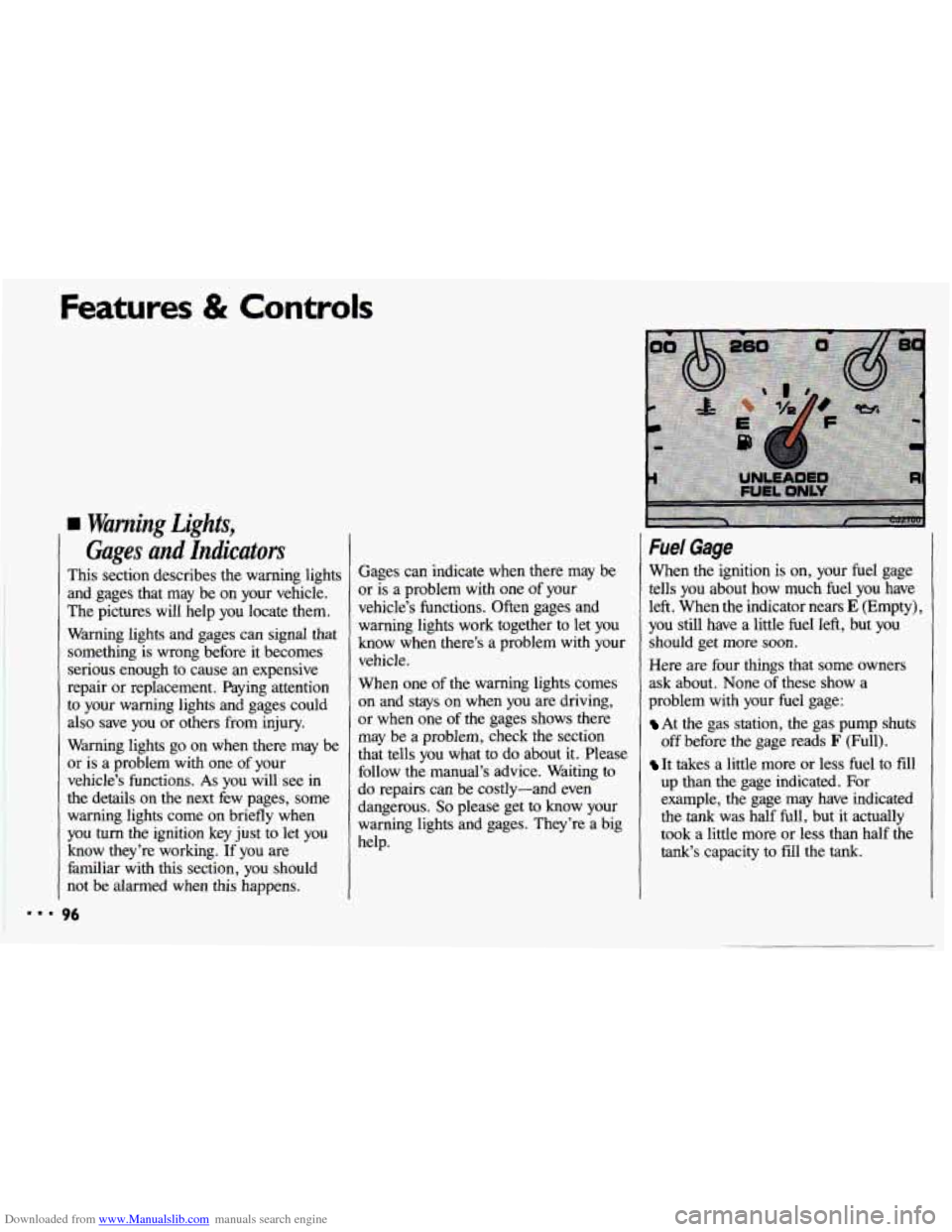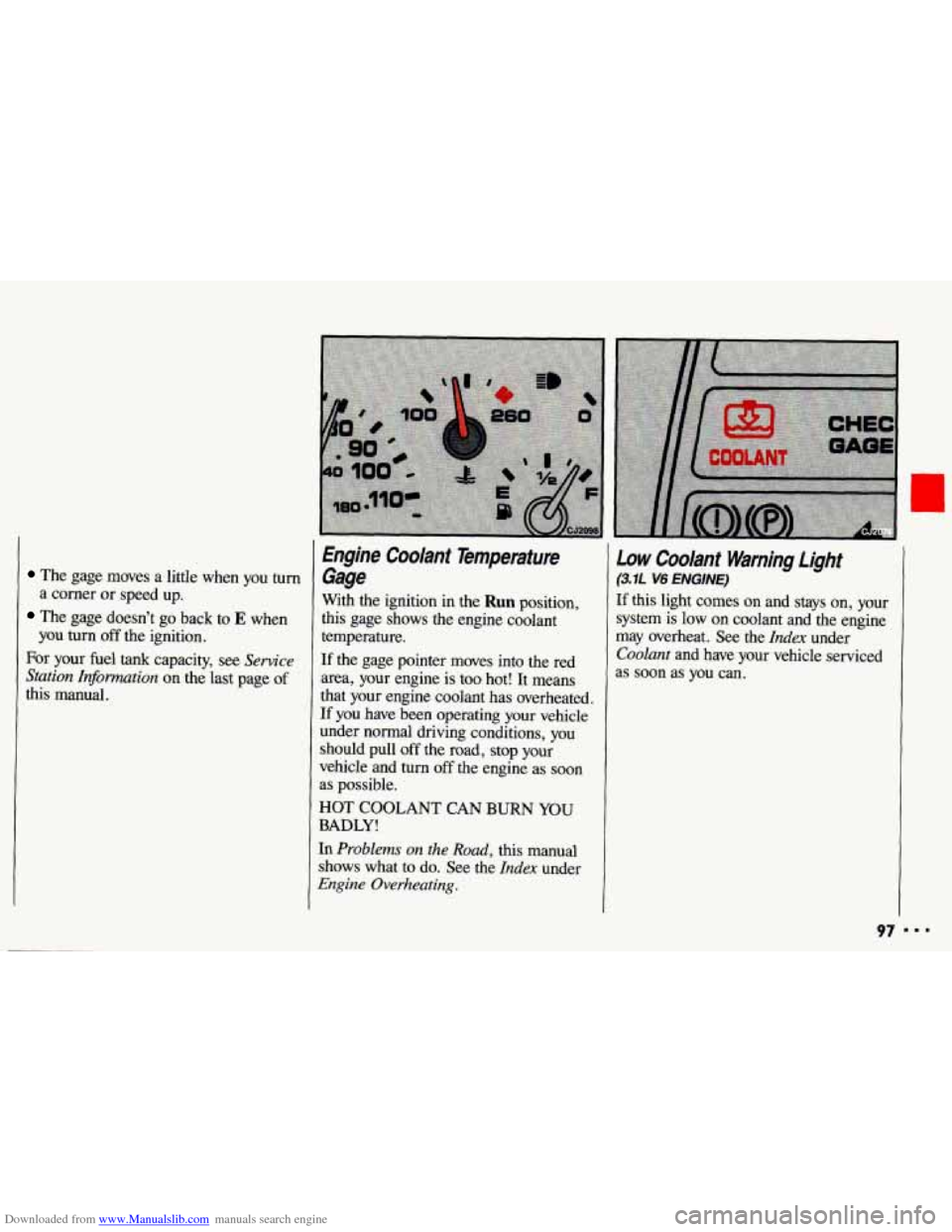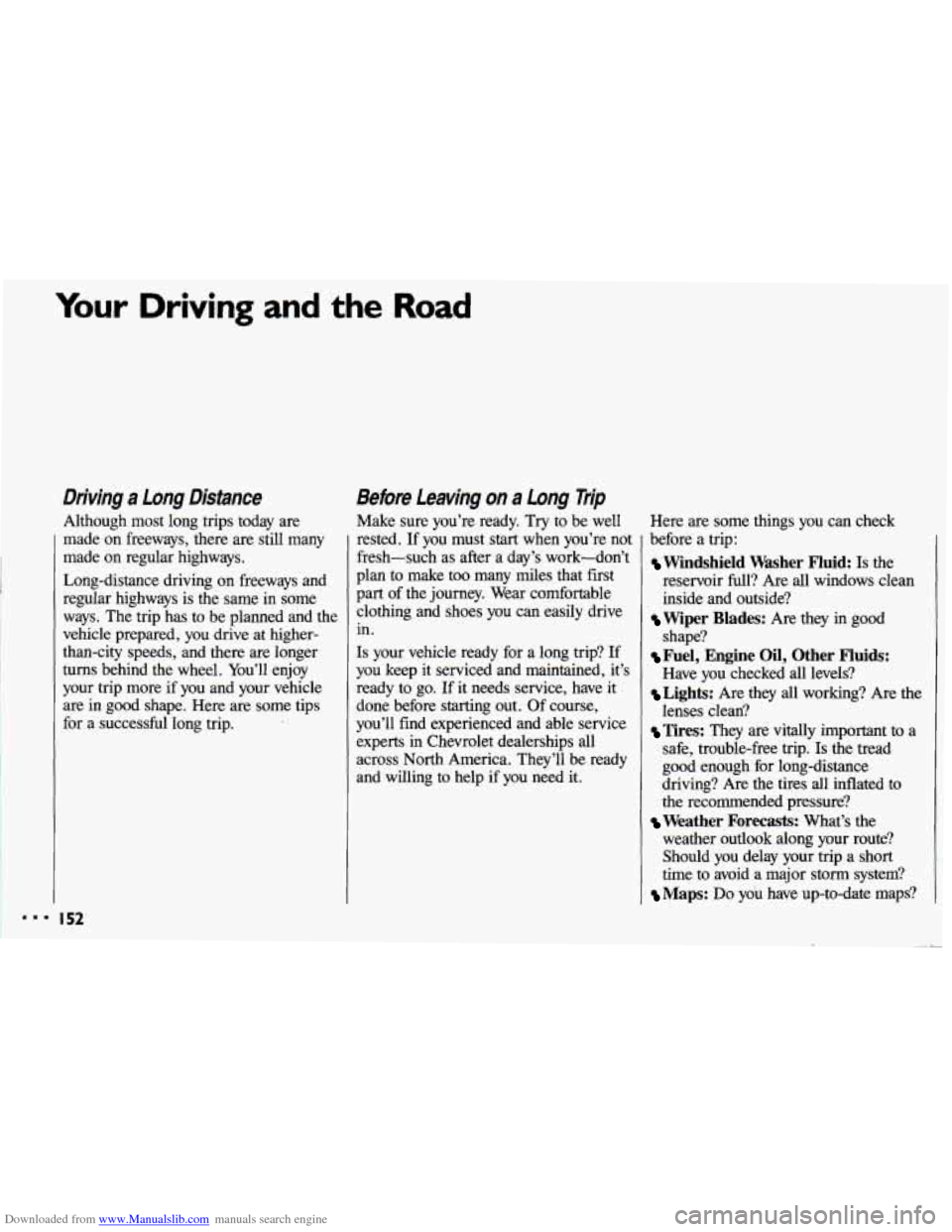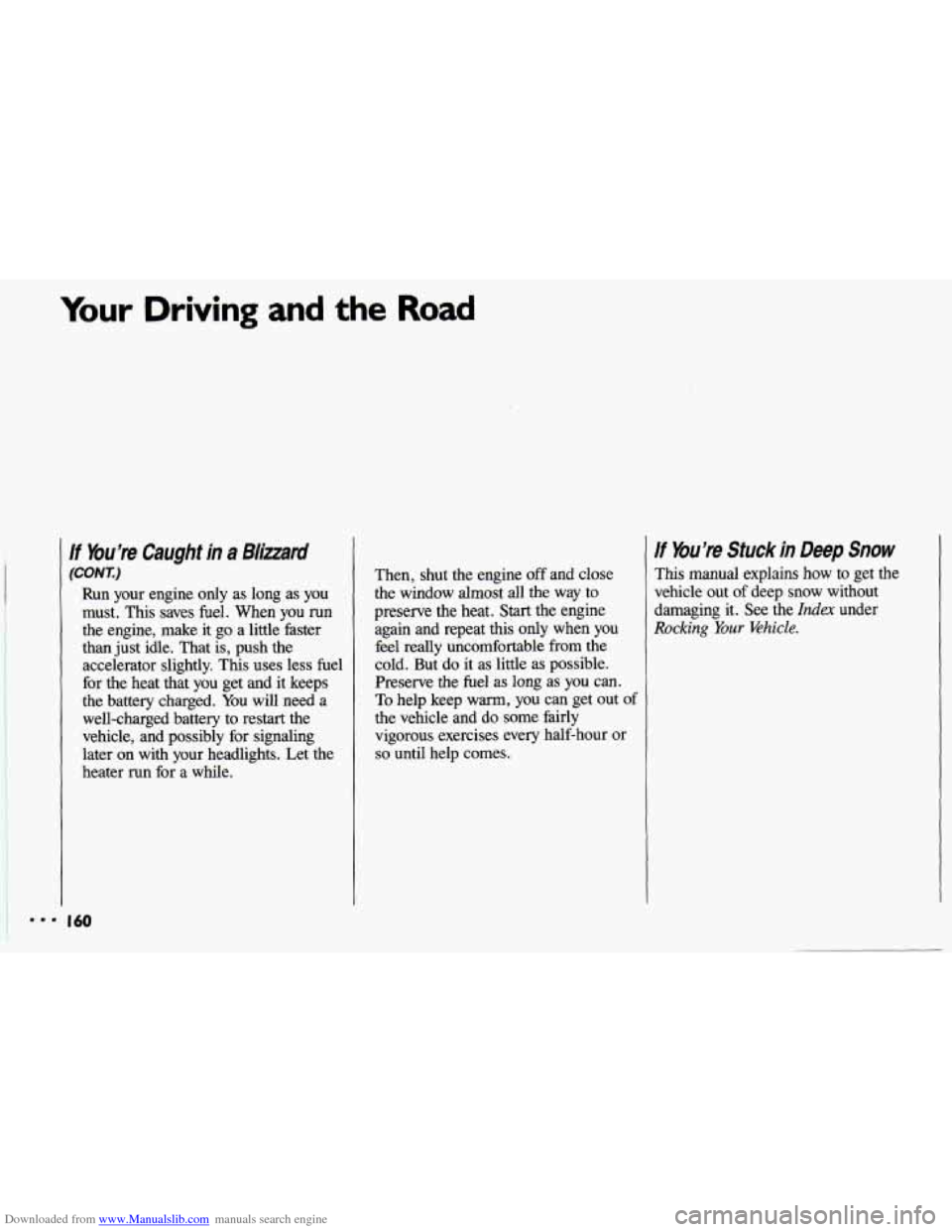Page 98 of 308

Downloaded from www.Manualslib.com manuals search engine Features & Controls
Warning Lights,
Gages and Indicators
This section describes the warning lights
and gages that may be on your vehicle.
The pictures will help
you locate them.
Warning lights and gages can signal that something is wrong before it becomes
serious enough
to cause an expensive
repair or replacement. Paying attention
to your warning lights and gages could also save you or others from injury.
Warning lights
go on when there may be
or is a problem
with one of your
vehicle’s functions.
As you will see in
the details on the next few pages, some
warning lights come on briefly when
you turn the ignition key just to let you
know they’re working. If you are
familiar with this section, you should
not be alarmed when this happens. Gages can indicate when there
may be
or is a problem with one
of your
vehicle’s functions. Often gages
and
warning lights work together to let you
know when there’s a problem with your
vehicle.
When one of the warning lights comes
on and stays on when you are driving,
or when one
of the gages shows there
may be a problem, check the section
that tells you what to do about it. Please
follow the manual’s advice. Waiting to
do repairs can be costly-and even
dangerous.
So please get to know your
warning lights and gages. They’re a big
help.
Fuel Gage
When the ignition is on, your fuel gage
tells
you about how much fuel you have
left. When the indicator nears
E (Empty),
you still have a little fuel left, but you
should get more soon.
Here are four things that some owners
ask about. None
of these show a
problem with your fuel gage:
At the gas station, the gas pump shuts
off before the gage reads
F (Full).
It takes a little more or less fuel to fdl
up than the gage indicated. For
example, the gage may have indicated
the
tank was half full, but it actually
took a little more or less than half the
tank‘s capacity to fill the tank.
Page 99 of 308

Downloaded from www.Manualslib.com manuals search engine The gage moves a little when you turn
The gage doesn’t go back to E when
For your fuel
tank capacity, see Service
Station Information
on the last page of
this manual. a
comer or speed up.
you
turn off the ignition.
Engine Coolant Temperature
Gage
With the ignition in the Run position,
this gage shows
the engine coolant
temperature.
If the gage pointer moves into the red
area, your engine is
too hot! It means
that your engine coolant has overheated.
If you have been operating your vehicle
under normal driving conditions, you
should pull
off the road, stop your
vehicle and turn
off the engine as soon
as possible.
HOT COOLANT CAN BURN YOU
BADLY!
In Problems on the Road, this manual
shows what to do. See the
Index under
Engine Overheating.
Law Coolant Warning Light
(3.7L V6 ENGiNE)
If this light comes on and stays on, your
system is low on coolant and the engine
may overheat. See the
Index under
Coolant and have your vehicle serviced
as soon as
you can.
97
Page 104 of 308
Downloaded from www.Manualslib.com manuals search engine ..I
Features & Controls
I
Malfunction Indicator Lamp
(Check Engine Lighf)
A computer monitors operation of your
fuel, ignition and emission control
systems. This light should come on
when
the ignition is on, but the engine
is not running, as a check to show you
it
is working. If it does not come on at all,
have
it fixed right away. If it stays on, or
it comes on while you are driving, the
computer is indicating that
you have a
problem.
You should take your vehicle
in for service soon.
I02
If you keep driving your vehicle
with this light on, after a while the
emission controls won’t work as
well, your fuel economy won’t be
as good and your engine may not
run as smoothly. This could lead to
costly repairs not rwered by your
warranty.
Liftgate Ajar Light (WAGON)
This light will come on if the liftgate is
not fully closed. Have your vehicle
serviced
if this light comes on and stays
on after the liftgate is closed.
Page 105 of 308
Downloaded from www.Manualslib.com manuals search engine Check Gages light
This light will come on briefly when
you are starting the engine. If the light
comes on
and stays on while you are
driving, check your various gages
to see
if they are in the warning zones.
This light will also come on when the
fuel level is low, 1 to 3 gallons (3.8 to
11.4 liters).
103
Page 109 of 308

Downloaded from www.Manualslib.com manuals search engine r
Air Conditioning System
(OPTION)
The air conditioner and heater work
best if you keep your windows closed
while using them. Your vehicle also has
the flow-through ventilation system
described later in this section.
Lever Controls: The upper lever
changes the functions
of your system.
The lower lever changes the temperature
of the air coming through the system.
Slide the upper control lever to
OFF to
turn off the system.
I 3f : Selects the fan speed. To select
the force of air you want, turn the knob.
The fan is always running unless the
upper lever is moved to
OFF.
Air Conditioning
The upper lever has three air
conditioner settings.
On very hot days,
open the windows long enough to let hot
inside air escape. This reduces the
amount of work your air conditioner's
compressor will have to do, which
should help fuel economy.
A/C (Air Conditioning): Press this
button to operate the air conditioner
compressor. The indicator light will
glow when the button
is pressed. The air conditioner compressor
operates
whenever the
AIC button is pressed. It
also operates automatically (and the
light will glow) when in the
MAX
setting, or in the DEF (Defrost) setting
when the outside temperature is higher
than about
40°F (4.5"C).
MAX (Maximum): Use for maximum
cooling. This setting recirculates much
of the air inside your vehicle
so it
maximizes your air conditioner's
performance and your vehicle's fuel
economy.
I07
r
IIB
Page 135 of 308

Downloaded from www.Manualslib.com manuals search engine “Riding” your brakes can
cause them to averheat to the
point that they won’t work well.
You
might not be able to stop your
vehicle
in time to avoid an
accident. If you “ride” your
brakes,
they will get so hot they
slow you down. Avoid “riding” the
brakes.
I
will require a lot of pedal force to
‘‘Riding” the brakes wears them
out much faster. You would neec
costly brake replacement much
sooner than normal, and it also
reduces fuel economy.
If you keep pace with the traffic and
allow realistic following distances, you
will eliminate a lot of unnecessary
braking. That means better braking
and
longer brake life.
If your engine ever stops while you’re
driving, brake normally but don’t
pump your brakes.
If you do, the pedal
may get harder to push down.
If your
engine stops, you will still have some
power brake assist.
But you will use it
when you brake. Once the power
assist is used up,
it may take longer to
stop and the brake pedal will be
harder to push.
Page 154 of 308

Downloaded from www.Manualslib.com manuals search engine Your Driving and the Road
Driving a Long Distance
Although most long trips today are
made on freeways, there are still many
made on regular highways.
Long-distance driving on freeways and
regular highways is the same in some
ways. The trip has to be planned and the
vehicle prepared, you drive at higher-
than-city speeds, and there are longer
turns behind the wheel. You’ll enjoy
your trip more
if you and your vehicle
are in good shape. Here are some tips
for a successful long trip.
Before Leaving on a Long Trip
Make sure you’re ready. Try to be well Here are some things you can check
rested. If you must start when you’re not
fresh-such as after a day’s work-don’t
plan to make too many miles that
first
part of the journey. Wear comfortable
clothing and shoes you can easily drive in.
Is your vehicle ready for a long trip? If
you keep it serviced and maintained, it’s
ready to
go. If it needs service, have it
done before starting out. Of course,
you’ll find experienced and able service experts
in Chevrolet dealerships all
across North America. They’ll be ready
and willing to help if you need it.
I’
before a trip:
Windshield Washer Fluid: Is the
reservoir full? Are all windows clean
inside and outside?
shape?
Have you checked all levels?
lenses clean? safe, trouble-free trip.
Is the tread
good enough for long-distance
driving? Are the tires all inflated to
the recommended pressure?
weather outlook along your route?
Should you delay your trip a short
time to avoid a major storm system?
Maps: Do you have up-to-date maps?
Wiper Blades: Are they in good
Fuel, Engine Oil, Other Fluids:
Lights: Are they all working? Are the
Tires: They are vitally important to a
Weather Forecasts: What’s the
Page 162 of 308

Downloaded from www.Manualslib.com manuals search engine Your Driving and the Road
lf bu're Caught in a Blind
(CONT)
Run your engine only as long as you
must, This saves fuel. When
you run
the engine, make it go a little faster
than just idle. That is, push the
accelerator slightly. This uses less fuel
for the heat that you get and it
keeps
the battery charged. You will need a
well-charged battery to restart the
vehicle, and possibly
for signaling
later on with your headlights. Let the
heater run
for a while. Then,
shut the engine
off and close
the window almost all the way to
preserve the heat.
Start the engine
again and repeat this only when you feel really uncomfortable from the
cold.
But do it as little as possible.
Preserve the fuel
as long as you can.
To help keep
warm, you can get out of
the vehicle and do some fairly
vigorous exercises every half-hour
or
so until help comes.
If You're Stuck in Deep Snow
This manual explains how to get the
vehicle out of deep snow without
damaging it. See the
Index under
Rocking Your Ehicle.